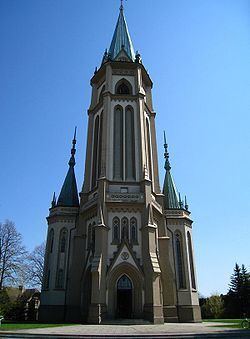Country Poland Gmina Wilamowice Area 10.41 km² Population 2,818 (2006) | County Bielsko Postal code 43-330 Voivodeship Silesian Voivodeship Local time Monday 12:31 AM | |
 | ||
Weather 13°C, Wind W at 6 km/h, 65% Humidity | ||
Wilamowice [vʲilamɔˈvʲit͡sɛ] (German: Wilmesau, Wymysorys: Wymysoü) is a small town in southern Poland, situated in the Bielsko County, Silesian Voivodeship (since 1999, previously in Bielsko-Biała Voivodeship, 1975–1998). The endangered language of Wymysorys is spoken here by about 70 native speakers, the majority of them elderly. The language was the main one of the town until the early communist period (1945–1956), when authorities repressed it. The inhabitants identifying themselves with the original culture are Wilamowiczanie.
Contents
Map of Wilamowice, Poland
History
The settlement of Wilamowice is predated by a nearby Stara Wieś (lit. Old Village). According to the tradition Stara Wieś was established after First Mongol invasion of Poland by settlers from Flanders, Friesland, Holland and Scotland in the course of the German Ostsiedlung. Soon after they moved on to another nearby place to found a new sister settlement, which was later first mentioned in 1326 in the register of Peter's Pence payment among Catholic parishes of Oświęcim deaconry of the Diocese of Kraków as Novovillamowicz (contemporary Wilamowice), whereas Stara Wieś was mentioned as Antiquo Willamowicz (contemporary Stara Wieś).
Politically both villages belonged to the Duchy of Opole and Racibórz and the Castellany of Oświęcim (ceded from Lesser Poland by Duke Casimir II the Just to Mieszko I Tanglefoot around 1177), which was in 1315 formed in the process of feudal fragmentation of Poland into the Duchy of Oświęcim, ruled by a local branch of Silesian Piast dynasty. In 1327 the duchy became a fee of the Kingdom of Bohemia. In 1457 Jan IV of Oświęcim agreed to sell the duchy to the Polish Crown, and in the accompanying document issued on 21 February the village was mentioned as Wylamowycze. The territory of the Duchy of Oświęcim was eventually incorporated into Poland in 1564 and formed Silesian County of Kraków Voivodeship.
Since the 15th Century the village was known by two German names : Wilmeshau Wilmesdorf. The place name was subject to many changes until the 18th Century when the name Wilmesau prevailed. Due to endogamy and the geographical isolation of the village lying inside the Polish language area of Bielsko-Biala the local language developed as a distinct regional dialect, which was used until the Second World War in everyday life.
Upon the First Partition of Poland in 1772 it became part of the Austrian Kingdom of Galicia. After World War I, fall of Austria-Hungary it became a part of Poland. It was annexed by Nazi Germany at the beginning of World War II, and afterwards was restored to Poland.
After the war almost all the Germans were driven out of the area and the village was renamed Wilamowice. The residents of Wilmesau / Wilamowice were allowed to stay by the Polish government because they were not of German descent. However the local language was banned and the population faced linguistic Polonization until 1956.
Famous people
Trivia
Twin towns – Sister cities
Wilamowice is twinned with:
